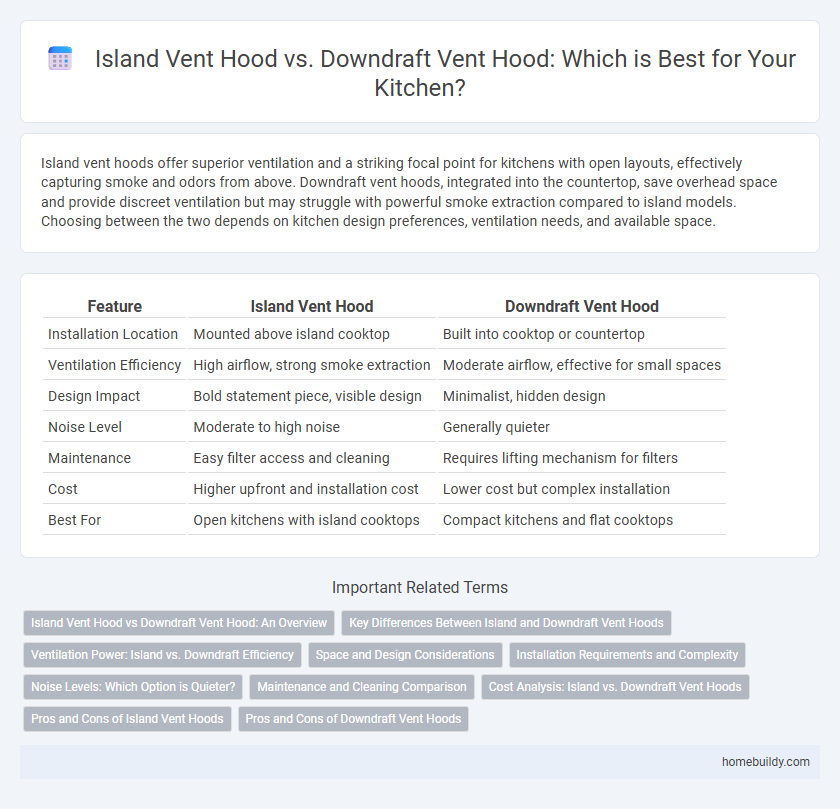Island vent hoods offer superior ventilation and a striking focal point for kitchens with open layouts, effectively capturing smoke and odors from above. Downdraft vent hoods, integrated into the countertop, save overhead space and provide discreet ventilation but may struggle with powerful smoke extraction compared to island models. Choosing between the two depends on kitchen design preferences, ventilation needs, and available space.
Table of Comparison
| Feature | Island Vent Hood | Downdraft Vent Hood |
|---|---|---|
| Installation Location | Mounted above island cooktop | Built into cooktop or countertop |
| Ventilation Efficiency | High airflow, strong smoke extraction | Moderate airflow, effective for small spaces |
| Design Impact | Bold statement piece, visible design | Minimalist, hidden design |
| Noise Level | Moderate to high noise | Generally quieter |
| Maintenance | Easy filter access and cleaning | Requires lifting mechanism for filters |
| Cost | Higher upfront and installation cost | Lower cost but complex installation |
| Best For | Open kitchens with island cooktops | Compact kitchens and flat cooktops |
Island Vent Hood vs Downdraft Vent Hood: An Overview
Island vent hoods are ceiling-mounted systems designed for kitchens with an island cooktop, offering powerful ventilation and aesthetic appeal by effectively capturing and removing airborne grease, smoke, and odors. Downdraft vent hoods are integrated into the countertop behind the cooktop, rising when needed to extract fumes, making them ideal for kitchens with limited overhead space but generally providing less ventilation strength than island hoods. Choosing between an island vent hood and a downdraft vent hood depends on kitchen layout, ventilation needs, and design preferences, with island hoods excelling in open space environments and downdraft hoods catering to sleek, unobtrusive installations.
Key Differences Between Island and Downdraft Vent Hoods
Island vent hoods are ceiling-mounted and designed for cooktops located on kitchen islands, providing strong upward ventilation and a focal design element. Downdraft vent hoods are installed within the cooktop or countertop, pulling air downward to vent it through ducts beneath the floor, ideal for kitchens with space constraints or minimal overhead cabinetry. Key differences include installation location, venting direction, and airflow efficiency, with island hoods generally offering more powerful extraction compared to downdraft models.
Ventilation Power: Island vs. Downdraft Efficiency
Island vent hoods provide superior ventilation power with high extraction rates due to their elevated placement and larger size, efficiently capturing cooking fumes from all sides. Downdraft vent hoods offer less ventilation efficiency as they rely on pulling air horizontally near the cooktop, often struggling to contain rising smoke and odor. For optimal kitchen air quality and powerful ventilation, island vent hoods are generally more effective than downdraft systems.
Space and Design Considerations
Island vent hoods require ample overhead clearance and are ideal for open kitchen layouts, offering a prominent centerpiece above the cooking island. Downdraft vent hoods integrate seamlessly into countertops, saving overhead space and providing a minimalist design, especially in kitchens with limited ceiling height or where unobstructed sightlines are preferred. Choosing between island and downdraft vent hoods largely depends on available vertical clearance and the desired aesthetic impact within the kitchen space.
Installation Requirements and Complexity
Island vent hoods require ceiling mounting with proper support and ductwork routing through the ceiling, often necessitating professional installation due to their complexity and size. Downdraft vent hoods are installed directly into the cooktop or countertop, offering a streamlined installation process but requiring carefully planned ducting beneath the surface to effectively vent air. The complexity of island vent hood installation is generally higher compared to downdraft systems, which are favored for kitchens with limited overhead space but demand precise countertop modifications.
Noise Levels: Which Option is Quieter?
Island vent hoods typically produce more noise due to their larger motor capacity and open placement above the cooktop, which can amplify sound. Downdraft vent hoods are generally quieter since they are built into the countertop and use smaller, more enclosed fans with reduced airflow noise. Choosing a downdraft vent hood can significantly minimize kitchen noise levels compared to traditional island vent hoods.
Maintenance and Cleaning Comparison
Island vent hoods typically require less frequent maintenance due to their easily accessible filters and open placement, making thorough cleaning simpler compared to downdraft vent hoods. Downdraft vent hoods, often installed within countertops, demand more meticulous cleaning to prevent grease buildup in confined spaces and require careful handling to maintain mechanical components. Regular upkeep of island vent hoods ensures optimal airflow, while downdraft systems need consistent attention to avoid reduced ventilation efficiency caused by hidden residue accumulation.
Cost Analysis: Island vs. Downdraft Vent Hoods
Island vent hoods typically cost between $700 and $2,000, with installation expenses varying based on ceiling height and ductwork complexity. Downdraft vent hoods range from $500 to $1,500 but often require more intricate under-counter installation, increasing labor costs. Overall, island vent hoods present higher upfront costs but tend to offer more efficient ventilation and durability compared to downdraft models.
Pros and Cons of Island Vent Hoods
Island vent hoods offer superior ventilation coverage for cooktops located on kitchen islands, efficiently capturing steam, smoke, and odors from all sides. Their prominent, ceiling-mounted design adds an elegant focal point to open-concept kitchens but requires ample overhead space and professional installation. However, island vent hoods tend to be more expensive and louder than downdraft vent hoods, with the potential for grease buildup on exposed surfaces needing regular cleaning.
Pros and Cons of Downdraft Vent Hoods
Downdraft vent hoods offer a sleek, space-saving design ideal for kitchens with limited overhead clearance or open floor plans, effectively removing smoke and odors directly from the cooktop surface. However, their extraction power typically falls short compared to island vent hoods, potentially leading to less efficient ventilation in high-cooking environments. Installation complexity and higher maintenance costs are additional considerations, as downdraft systems require integrated ductwork beneath the countertop.
Island vent hood vs Downdraft vent hood Infographic

 homebuildy.com
homebuildy.com